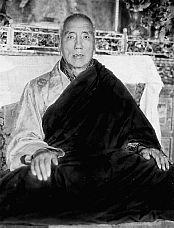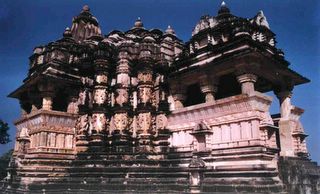Toà lâu đài Potala - Một kho tàng văn hoá Phật Giáo Tây Tạng.
China View, Dec 6, 2004
 Lhasa, Tibet (China) - Một chút nhỏ nhoi của toà lâu đài cổ kính Potala của thế kỷ thứ 7 co`n xót lại. Toà lâu đài được xây lên như là một nơi để vua Songtsen Gampo tu tập thiền định nhân cuộc hôn lễ của vua với nữ vương Wencheng của triều đi`nh nhà Đường (Tang Court). Nằm trên cùng của ngọn đồi đỏ (Red Hill) trong Lhasa, toà lâu đài đã được kiến trúc lại vào thế kỷ thứ 17, nó được xây dựng lại bởi Đức Dalai Lama thứ 5 và trở thành toà lâu đài mùa đông của Đức Dalai Lama từ lúc đó. Toà lâu đài có 13 tầng và 1,000 pho`ng mà người ta có thể nhi`n thấy từ xa rất nhiều cây số.
Lhasa, Tibet (China) - Một chút nhỏ nhoi của toà lâu đài cổ kính Potala của thế kỷ thứ 7 co`n xót lại. Toà lâu đài được xây lên như là một nơi để vua Songtsen Gampo tu tập thiền định nhân cuộc hôn lễ của vua với nữ vương Wencheng của triều đi`nh nhà Đường (Tang Court). Nằm trên cùng của ngọn đồi đỏ (Red Hill) trong Lhasa, toà lâu đài đã được kiến trúc lại vào thế kỷ thứ 17, nó được xây dựng lại bởi Đức Dalai Lama thứ 5 và trở thành toà lâu đài mùa đông của Đức Dalai Lama từ lúc đó. Toà lâu đài có 13 tầng và 1,000 pho`ng mà người ta có thể nhi`n thấy từ xa rất nhiều cây số.Lâu đài Potala được chia làm hai khu vực--khu vực bên ngoài là toà lâu đài màu trắng, và khu vực bên trong là toà lâu đài màu đỏ, sau này nhiều ngôi chùa được xây dựng ở trong khu vực toà lâu đài màu đỏ này, và có những ngôi mộ chứa di hài của các vị Dalai Lama. Với chiều cao 117 meters, toà lâu đài Potala đã là một toà nhà cao nhất thế giới cho tới thế kỷ thứ 20 những kiến trúc sư đã tạo những đồ án cho những toà nhà mới vượt xa độ cao của toà lâu đài Potala--nhưng kiểu kiến trúc thi` không được uy nghi, oai vệ như toà Potala.
Ở đó có nhiều cung điện nhỏ nằm trong cung điện lớn. Toà lâu đài đứng sừng sững giống như một thành quách tráng lệ nguy nga trong thiên đàng. Tượng của vua Songtsen Gampo và nữ vương Wencheng được thờ phượng trong cung điện này. Trong số các ngôi chùa thờ tự các vị Dalai Lamas, có một ngôi chùa thờ Đức Dalai Lama thứ 5 là cao nhất với 14 meters chiều cao. Mười một lượng vàng đã được dùng để mạ, những thiết kế và trang hoàng tất cả được khảm kim cương và ngọc trai cũng như những loại đá qúi màu xanh lục, đá mã não và đá san hô.
Toà lâu đài Potala là một kho tàng văn hoá Phật giáo Tây Tạng, từ khi nơi đây có một cuốn kinh Phật được viết bằng tay với chữ bằng vàng. Có rất nhiều nghệ thuật điêu khắc chạm trỗ nhiều màu sắc và những bức hoạ ghi chép những sự kiện về Đức Phật theo truyền thống văn học nhân gian và đời sống của những người Tây Tạng thời xưa. Toà lâu đài Potala xứng đáng với tước hiệu triển lãm nghệ thuật và viện bảo tàng; nó cũng là biểu tượng sự uyên thâm và quyền lực của người Tây Tạng.
Toà lâu đài Potala is giống như một cung điện của tu viện, đã là một nơi được coi như là trung tâm Phật giáo Tây Tạng và cũng là trung tâm quyền lực của chính phủ Tây Tạng cũ.
Bản dịch của Minh Hạnh
The Potala Palace -- a treasure house in Lhasa
China View, Dec 6, 2004
Lhasa, Tibet (China) -- Little remains of the original Potala Palace of the seventh century, built as a place for meditation by King Songtsen Gampo on the occasion of his marriage to Princess Wencheng of the Tang Court. Standing atop the Red Hill in Lhasa, the current structure dates from the 17th century; it was rebuilt by the 5th Dalai Lama and became the Winter Palace of the Dalai Lamas from that time. The 13-story building of 1,000 rooms can be seen from many miles away.
The Potala is divided into two sections--an outer section, the White Palace, and an inner section, the Red Palace, the latter containing the temples and reliquary tombs of the Dalai Lamas. The entire building is a structure of stone and timber. At a height of 117 meters, the Potala was the world's tallest building until 20th-century architects designed cityscapes of new buildings that far surpassed the Potala in height--but not in its architectural majesty.
There are small palaces within grand palaces. The Potala stands so high that it looks like a magnificent castle in the heavens. The statues of King Songtsen Gampo and Princess Wencheng are the worship. Among the eight tomb pagodas of the Dalai Lamas, the tomb of the fifth Dalai Lama is the most extravagant,14 meters high. Eleven thousand ounces of gold were used in the gold plating, the designs and decorations all inlaid with diamonds and pearls as well as turquoise, agate, and coral stones.
The Potala is a treasure house, since it contains the golden handwritten Buddhist scriptures, valuable gifts from Chinese emperors, and a lot of priceless antiques. There are many colorful sculptures and paintings chronicling Buddhist folklore and ancient Tibetan life. The Potala Palace deserves the title of art gallery and museum; it is also a symbol of the wisdom and power of the Tibetan people.
http://buddhistchannel.tv/index.php?id=18,355,0,0,1,0
 <<>>Ngài Jamyang Khyentse Wangpo
<<>>Ngài Jamyang Khyentse Wangpo <<>>
<<>> 